
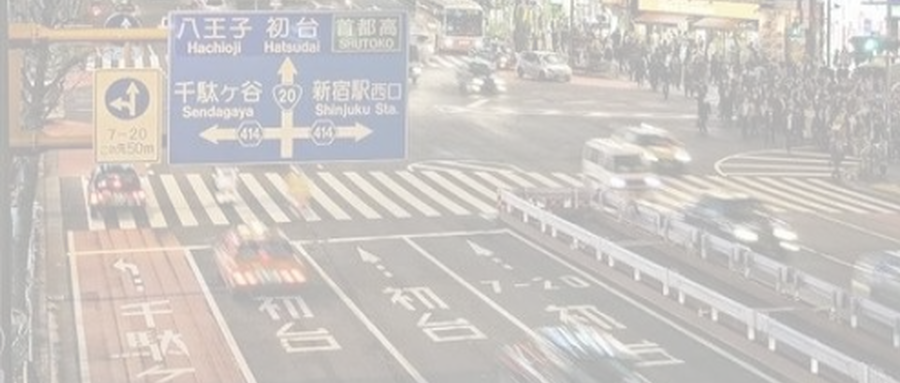
Japan, as the world's fifth largest producer of greenhouse gases, had a total carbon emission of 1.188 billion tons in 2017, accounting for 92.0% of its total greenhouse gas emissions. Since 1990, Japan's total carbon dioxide emissions have remained at almost the same level with per capita emissions, although the former rises and then falls from 1993 to 1998 and from 2009 to 2017. In the past 30 years, Japan's carbon emission trend is closely related to its features of low economic growth rate, small changes in energy structure and basically constant population size.
Figure 1: Trends in total CO2 emissions and CO2 emissions per capita
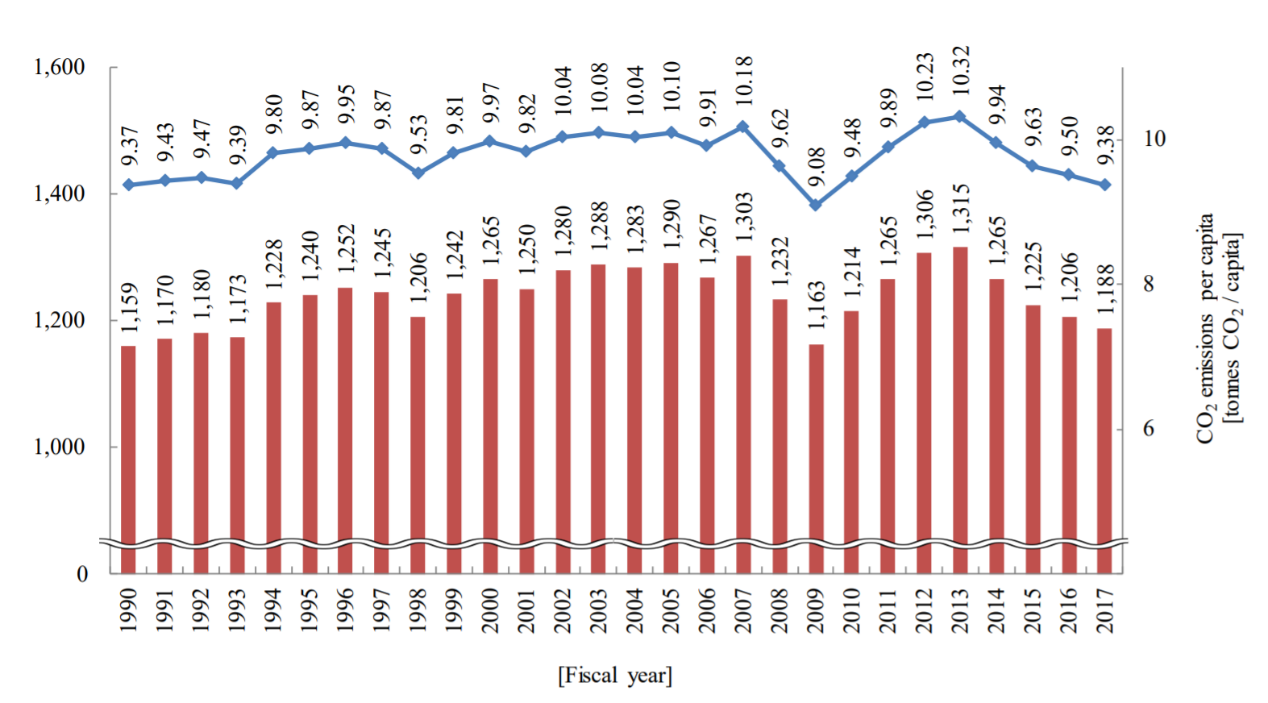
Source: National Greenhous Gas Inventory Report of Japan 2019
In the past 30 years, the distribution of carbon emissions from Japan’s industries and sectors have undergone obvious changes. Carbon dioxide emissions from energy (mainly fossil fuel) consumption accounted for 95.0% of the total emissions. According to the data provided by Figure 2., the author initially calculated that emissions from the energy industry accounted for 42.7% in 2017, followed by the manufacturing and construction industry of 23.0%, and then the transport sector of 17.3%. Between 1990 and 2017, emissions from the energy industry rose by 37.6%; emissions from the manufacturing and construction industry fell by 22%; emissions from the transport sector increased slightly by 2.1%, which is similar to the increase rate of the total emissions over the same period. The carbon emissions of Japan’s transport sector peaked at 267 million tons in 2001 and fell to 205 million tons in 2017, a decrease rate of 23% in 16 years.
Background of carbon emission reduction in Japan’s transport sector
To discuss Japan's experience in carbon emission reduction in the transport sector in the past 30 years, it is necessary to state Japan's economic development and population growth trend during the same period, since the above two aspects are structural factors that affect carbon emission reduction in the transport sector. According to the data from the World Bank1, calculated by the Constant Price in 2010 (US$), Japan's GDP increased from 4.704 trillion in 1990 to 6.141 trillion in 2017, an increase rate of 31% in 27 years. During the same period, Japan’s total population rose from 123.5 million in 1990 to 126.8 million in 2017, an increase rate of only 2.67%. More importantly, Japan's population peaked at 128.1 million in 2010, which kept falling year by year from then on. Japan might be the only country in the developed economies that faces a huge challenge of demographic decline.
Under such a background, we will see what we could learn from Japan's transport sector in reducing carbon emissions and improving efficiency. Since the carbon dioxide emissions from road traffic account for the largest proportion of the total emissions from the transport sector, this article will introduce Japan’s measures of emission reduction for the road traffic to achieve the carbon dioxide emission reduction target, including some cases of sustainable transport policies in some Japanese cities, for China's reference in establishing a low-emission transport system.
Figure 2: Trends in CO2 emissions in each sector
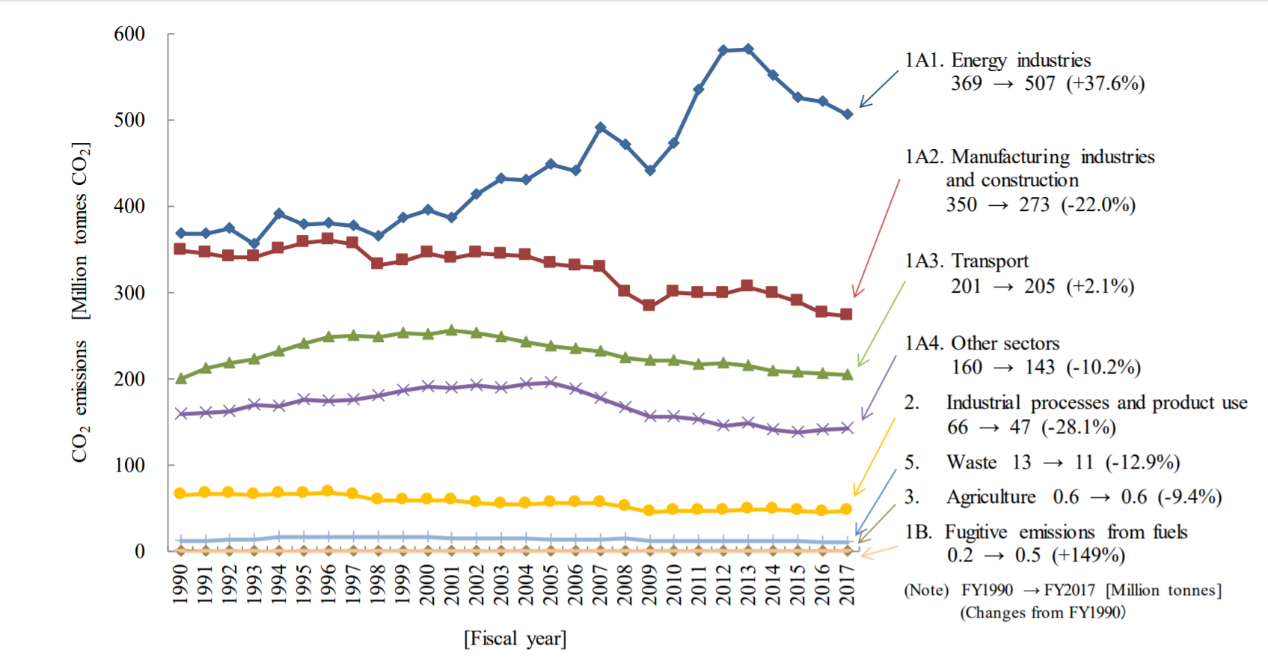
Source: National Greenhous Gas Inventory Report of Japan 2019
Policies of the transport sector to combat climate change
In order to achieve Japan's commitment under the Kyoto Protocol, Japan's Ministry of Land, Infrastructure, Transport and Tourism proposed countermeasures to combat climate change for the first time in 2002, under the guidance of which, Japan fulfills its commitments. In 2016, Japan announced the latest countermeasures, and revealed the greenhouse gas reduction targets throughout the country and for various sectors, among which, the carbon emission of the transport sector in 2030 will be 28% lower than that in 20132. Therefore, a sustainable transport system is the only way to achieve this target. The countermeasures proposed by Japan's transport sector mainly cover the following two aspects: the popularization and application of eco-friendly vehicles and the shift to a traffic system dominated by public transport with less environmental loads.
Popularization and application of eco-friendly vehicles
(1) Improvement of fuel economy
Automobile manufacturers are targeted to promote technological innovations for improvement of fuel economy. For passenger cars, trucks and buses, the fuel economy targets are set according to the "Top Runner" standard, i.e. the fuel economy target value for a given vehicle weight category is set based on the world's leading fuel economy performance for that weight category so far. From 2000 to 2016, Japan saw significant improvement in the average fuel economy of new gasoline-powered cars.
Figure 3: Average fuel efficiency of domestic new gasoline-powered passenger cars

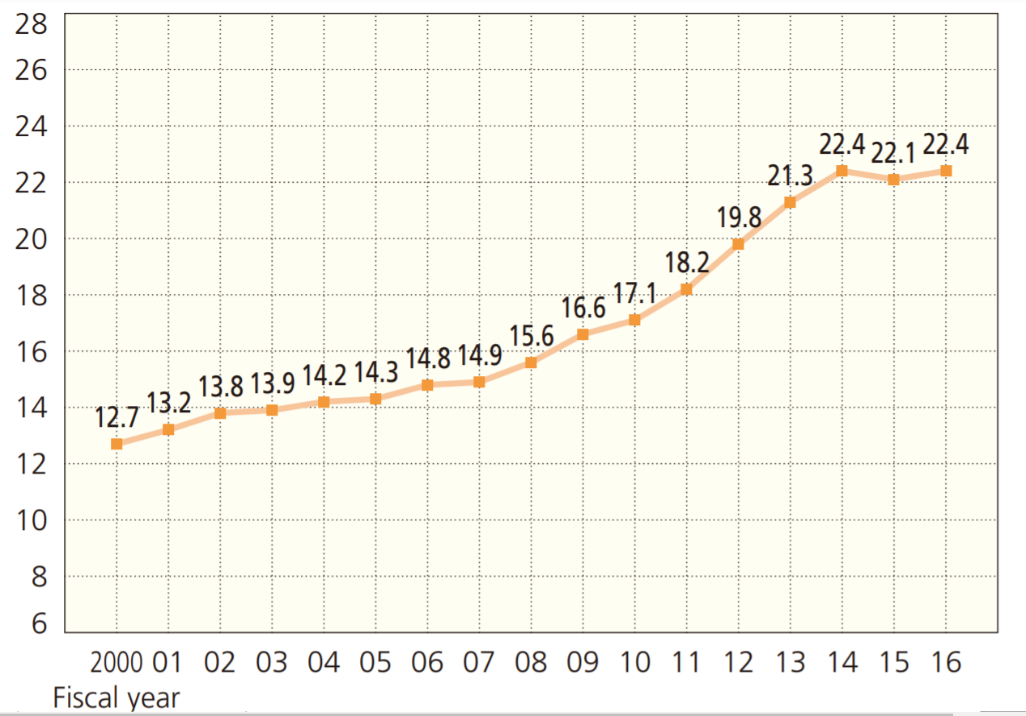
Source: Japan Automobile Manufacturers Association
(2) Promotion of eco-friendly vehicles
The government funded procurement program of eco-friendly vehicles and encourages the popularization and application of eco-friendly vehicles. For example, from April 1, 2017 to March 31, 2019, buyers of new energy vehicles (including hybrid electric vehicles, plug-in hybrid electric vehicles, electric vehicles, fuel cell electric vehicles, etc.) were exempted from purchase tax, and buyers of second-hand new energy vehicles enjoyed a reduction of the purchase tax of US$ 4,200.3 From 2009 when the government first launched tax incentive and subsidy plans for the purchase of eco-friendly vehicles, Japan's sales of new energy vehicles have risen sharply in the total sales of passenger cars. In 2017, the number of new energy vehicles registered accounted for more than 36% of the total number of new passenger car registered (Figure 4), gradually approaching the target set by the Japanese government that, by 2030, the share of new energy vehicle sales accounts for 50%-70% of the total sales of new vehicles.4
Figure 4: Trends in next-generation vehicle share in new passenger car registrations
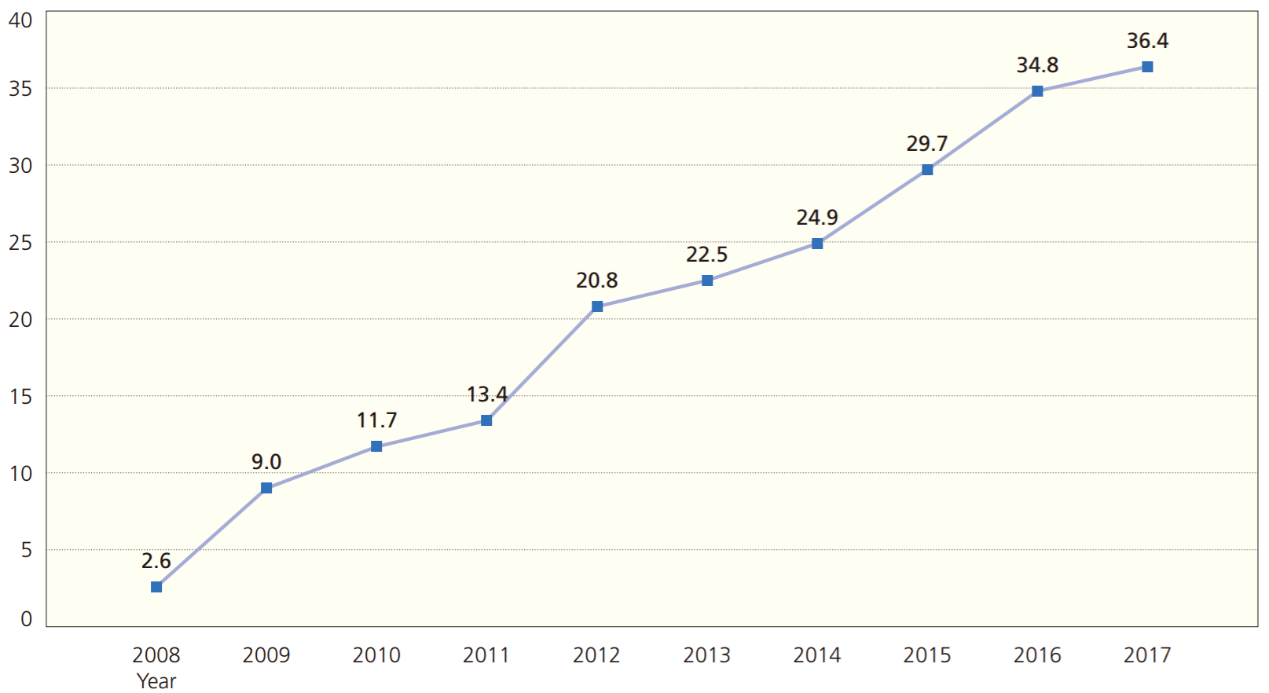
Source: Japan Automobile Manufacturers Association
(3) Promotion of eco-driving
Eco-driving is promoted for the main purpose of improving daily driving skills to reduce fuel consumption and carbon emissions. The Japanese government has been promoting eco-driving for many years. The Promotion Committee set up by the Ministry of Land, Infrastructure, Transport and Tourism has formulated "Ten Tips for Eco-driving", including pre-trip, on-the-road and daily vehicle maintenance that are promoted in the international conferences and exchanges. Regarding the effectiveness of eco-driving for energy-saving and emission reduction, Japanese scholars have proved through effect evaluation that eco-driving reduces the fuel consumption of Japanese vehicles by 10%-20%, which is proportional to carbon dioxide emissions 5. For details in Eco-driving, please refer to ‘Changes in driving behavior and carbon emission reduction in transport sector: experience from Seoul and Tokyo’ in the “Energy Review 2018”.
(4) Measures to improve traffic flow and promotion of low carbon road facilities
Vehicles running at faster speeds will produce less carbon dioxide. For example, vehicles with an average speed of 60-70km/h emit about 1/2 of the carbon dioxide emitted by vehicles with an average speed of 10km/h. So it is very effective for reducing the carbon emissions from fuel consumption by improving the smoothness of traffic roads.
Traffic signal measures. More efficient traffic signal operation and centralized signal control contribute to more stable traffic flow.
Congestion mitigation based on the Intelligent Traffic System (ITS). Traffic congestion will be alleviated through the use of ITS that will provide real-time congestion information and plan the optimal route.
Promotion of ETC (Electronic Toll Collection). Promotion of ETC on toll roads will reduce slow flow and road congestion caused by manual toll collection;
Improvement of the cycling environment. Bicycles will replace some automobiles by redistributing road space, and rectifying cycling space and facilities in bicycle parking lots;
Improvement of road network. The main road network is connected through loop roads and the like, and traffic flow is expanded by improving intersections;
Installation of LED road lighting. During arrangement and change of road lighting, it is required to promote the energy-saving LED road lighting.
Shift to the public transport with less environmental loads
(1) Facilitating the convenience of public transport such as bus and railway
For the purposes of maintaining the traffic system, promoting tourism and coping with environmental problems, the Japanese government has established and implemented a Coordinative Plan to rearrange the public transport network for different regions to promote public transport.
Promotion of buses based on bus positioning system. Bus location and transfer information is provided at all bus transfer stops to improve bus convenience and make the residents less opposed to transfer;
Accessibility of railway stations. In a severe aging society, the barrier-free railway stations are promoted for security and convenience of the elderly, physically handicapped, etc.
Development of Light Rail Transit (LRT). More light rails are connected with buses for the convenience of transfer so as to improve the overall convenience of public transport;
Improvement of station square traffic node. In order to improve railway station transfer and the barrier-free walking space, the station square, traffic aisle, public parking lot and the like are optimized.
(2) Promotion of Mobility Management
Mobility management is a communication-oriented transport policy, which promotes change of commuters’ commuting attitude and behavior, e.g., appropriately using public transport and bicycles more often to avoid excessive use of private cars, for the purpose of creating a good traffic environment for society and individuals.
Eco-Commuting, a kind of mobility management, aims at facilitating the transformation from private cars to public transport. An employee is specially assigned in each company office to be responsible for studying the ideal commuting means, providing timetables and road maps of buses, subways and trains, and checking commuting allowances. Toyota, a famous automobile city with the highest car parc and usage in Japan, has set up the "Toyota Eco-traffic Promotion Association" that proposed Eco-Commuting to solve the traffic congestion during commuter time. In addition to changing the means of transport dominated by cars, other environmental-friendly measures encouraged include commuting with shared vehicles and at off-peak hours.
Example: Sustainable transport strategy in Toyama
Toyama, one of Japan's Eco Model Cities, has introduced a bicycle sharing system and incorporated LRT into a compact city, in addition to the basic public transport system. Before that, Toyama had the lowest population density among all the densely populated counties in Japan. Residents there bought a large number of private cars and suburban houses, leaving the downtown area "empty". For this, train and bus companies began to cut routes to cope with the decrease in demand, making it more inconvenient to travel by train and bus, in particular for children and the elderly. Therefore, in 2003, Toyama set up the Compact City Development Group that was committed to the development of a compact city through cooperation with residents, enterprises and local governments. The core of the plan is to introduce a new LRT network. Toyama adopted a multi-center method rather than a single-center method to connect the existing facilities with the light rail, and introduced low-floor light rail and barrier-free platforms to provide more convenience. From then on, people anywhere can walk to the public transport stations in Toyama. In addition, Toyama has also launched the Cyclocity. There are more than 150 special bicycles at 15 bicycle shares throughout the city center. Users can rent and return bicycles at any bicycle share at any time.
Policy recommendations
In order to remain committed to its Nationally Determined Contributions proposed in the Paris Agreement (compared with 2013 level, a reduction in greenhouse gas emissions of 26% in 2030), Japan has developed a series of policies and plans and kept working for them to create an energy-efficient transport system by multiple means such as efficiency improvement, fuel substitution, and system reengineering, thereby reducing the carbon dioxide emissions of the transport sector.
China, as a large energy resource consumer, is challenged with energy saving and emission reduction during its rapid economic development. In the past 20 years, the increase in the number and usage of private cars in China mainly contributed to the increase in carbon dioxide emissions in the transport sector. In order to develop sustainable transport, China could learn from Japan's advanced experience, start from changing the way residents travel, and focus on the development of urban public transport network and service capacity, which constitutes one of the long-term key plans for the transport sector to mitigate climate change. Japan's experience shows that any action should start with details and small changes. Carbon emissions will be reduced with the gradual improvement of the operating efficiency of the traffic system. This paper puts forward the following suggestions:
Invest more in the construction of bicycle lane and public transport (including buses and light rails, etc.) systems to lay foundations for a complete transformation of traffic system infrastructure;
Facilitate the popularization of new energy vehicles while controlling the number of private cars, set up charging piles or stations of reasonable network layout, and realize the low carbon development goal of the transport sector by replacing traditional fuel vehicles;
Promote the popularization of intelligent transport systems, provide more accurate and faster road congestion information and shortest route suggestions, and adjust the operation of traffic signal systems according to the traffic flow, thus improving efficiency;
Establish organizations to promote low carbon behaviors such as eco-driving and eco-commuting, and call for low carbon and energy-saving driving behaviors with government agencies, major universities, enterprises and public institutions, etc.
Conclusion
In the long run, the establishment of a low carbon and sustainable traffic policy system in response to combat climate change set a model for other countries and economies, while Japan may also learn from other countries. For example, for coping with climate change, it is necessary to support the development of electric transport system through low carbon transformation of electric system. Therefore, more international exchanges and cooperation will promote countries to cope with low carbon development in the transport sector and mitigate climate change more effectively.
References
1. The World Bank Development Index Link:https://data.worldbank.org.cn/indicator/NY.GDP.MKTP.KD?end=2018&locations=JP&start=1990
2.Global Warming Countermeasures (Cabinet Decision), the Ministry of the Environment, 2016. Link http://www.env.go.jp/press/files/jp/102816.pdf
3.The Motor Industry of Japan 2018, Japan Automobile Manufacturers Association
4. CO2 Emissions Reduction in Japan’s Road Transport Sector, Japan Automobile Manufacturers Association
5.How does driving behavior change when following an eco-driving car, Ryosuke Ando, Yasuhide Nishihori, Procedia Social and Behavioral Sciences, URL: https://core.ac.uk/download/pdf/81126038.pdf.




